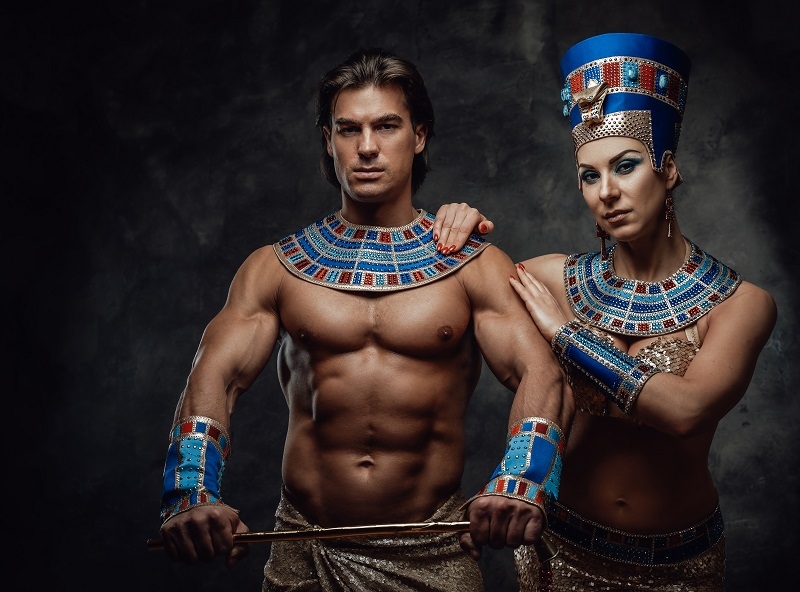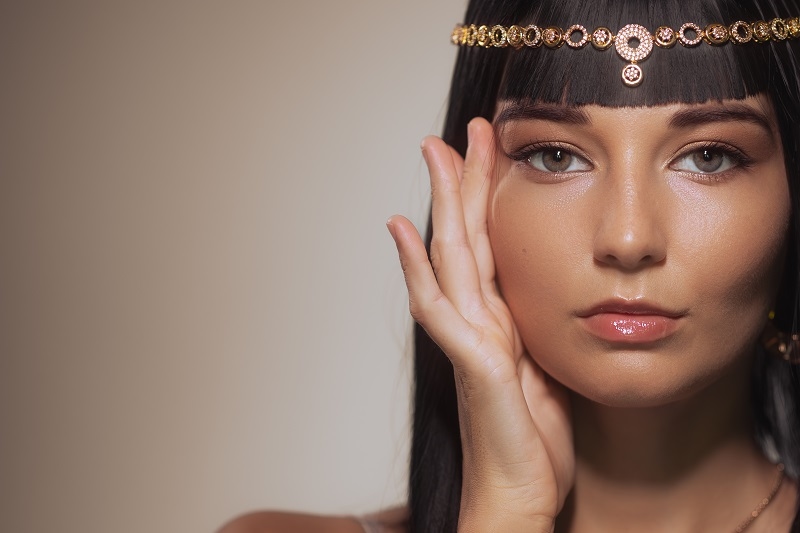
Hairstyles in ancient Egypt were more than just an aesthetic choice; they symbolized power, authority, and social standing. Egyptian hairstyles and power are closely related to the cultural practices and social structures that existed during those times. From elaborate wigs to shaved heads, hair was a significant communication tool that reflected one's position in society, marked differences in social status, and portrayed symbolic meanings.
In ancient Egypt, hair was a defining feature and an expression. Today, most of the world considers hair a fashionable statement. In the eyes of Egyptians, however, hair was essential to the practice of their culture. The head, with or without hair, symbolized status, religion, and power in the person it represented.
For example, the Pharaohs- Gods on Earth wore certain hairstyles that signified their divine authority. The hair was not just for cosmetic purposes; it also had symbolic aspects that represented their power and connection to the gods. Similarly, high-ranking officials, priests, and aristocrats wore their hair as a status symbol.
Hairstyles were frequently used in ancient Egypt to indicate social standing. Due to their rigorous circumstances, commoners and laborers tended to wear practical and uncomplicated hairstyles, whilst the higher classes preferred more complex designs. These hairstyles were precisely designed to represent riches and power, and they frequently featured complex braids, beads, and gold and precious stone accents.
The use of wigs is one of the notable trends of the elite class, which must be noted here. Wigs were an extravagant commodity made up of human or plant fibers; they were decked with more decorations. The style and quality of wigs gave the status of a particular person. They used to put on large-sized, styled wigs to make people understand about their status within society. Not only did these signify fashion but, above all, these were potent symbols of higher positions in the society.
On the other hand, commoners may shave their heads to deal with the scorching heat and keep themselves clean. They used simple wigs made of cheaper materials for special occasions or religious ceremonies.
Hair symbolism was also profoundly ingrained in religious and cultural traditions. Priests, for example, would shave their heads totally to demonstrate purity and devotion to the gods. This practice emphasized the concept that losing one's hair represented a rejection of earthly problems and a focus on spiritual matters.
The hairstyle of children was also significant. Young boys and girls were characterized by a special sidelock of youth, in which one single lock of hair is left on the side of the head while the rest is shaved off. The hairstyle symbolized youth and innocence and meant that the child was under the protection of the deity “Hathor”, who is associated with motherhood and fertility.
Symbolic hair practices also extended to funerary customs. In preparation for the afterlife, Egyptians often included wigs and hairpieces in tombs to ensure the deceased maintained their social status and identity in the next world. This practice highlights the enduring cultural significance of hairstyles in ancient Egyptian beliefs about eternity and the afterlife.
In addition to social status, hairstyles also highlighted the role of gender in ancient Egyptian society. Men and women had differing styles that encouraged social expectations of and roles regarding people. Women with a higher standing status were allowed to wear wigs that looked very long with curls or braids. Their hairdo represents fertility, beauty, and also high social rank.
Men's hairstyles, by contrast, were more conservative yet no less full of meaning. Shaven heads or very short haircuts are common among the men, especially among military and bureaucratic personnel. Such a haircut made sense in the sweltering climate and symbolized discipline and readiness to serve.
This way, both genders applied perfumed oils and scents to the hair or their wigs to make them appealing but also signifying richness and being clean. Usage of such appearance also pointed toward the status as well as cultured refinement of that person.
Egyptian hairstyles changed throughout the centuries as a reflection of more fabulous historical trends and cultural shifts. In the Old Kingdom (2686–2181 BCE), hairstyles were pretty simple, as men and women often wore short or medium-length hair. Wigs started to become fashionable during this time and became more complex over time.
The Middle Kingdom (2055–1650 BCE) saw a rise in the complexity of hairstyles. Intricate braids and curls became fashionable among the elite, and wigs grew in size and sophistication. Hairstyles during this period often featured adornments like beads and ribbons, highlighting the wearer’s wealth and artistic sensibilities.
By the New Kingdom (1550–1069 BCE), styles became the most creative and symbolic expression. Wigs became almost standard equipment for members of the nobility. Headdresses and crowns in the form of distinct headgear that included elements such as the rearing cobra or the vulture remained integral parts of pharaohs and queens' styles to symbolize their divine authority.

Wigs were not mere accessories but a powerful tool of social and political expression. Wigs were an integral component of Pharaohs' public personas, conveying power, divinity, and authority. These wigs were worn with the headgear, making them even more identifiable as celestial rulers.
Queen Cleopatra, one of the most famous individuals in ancient Egyptian history, is often shown with the most ornate hairstyles and wigs. Her appearance reflected her royal status and political skill. Cleopatra's use of hair as a tool of power and seduction emphasizes how important hairstyles are in creating ideas of authority and influence.
Beyond royalty, wigs became a tool to display power in high-ranking officials and priests. Their rank and influence were quite well depicted through the quality and workmanship of the wigs. This way, wigs turned into a medium for negotiating social hierarchy and power.
Maintaining hairstyles is a task, especially for ancient Egyptians and also the elite ones. For example, the technique of making a wig was also an art very carefully done. Human hair, as well as other plant fibers plus beeswax, were used by professionals to create long-lasting and close-to-nature wigs that were then tinted and fashioned according to a person's desired style.
Hygiene was another aspect of hair care. The Egyptians considered hygiene and always used oils and perfumes for the maintenance of their hair and wigs. Such practices, far from being aesthetically based, were deeply rooted in the Egyptian culture's beliefs about purity and health.
To the commoners, hair maintenance was easier but important. Shaven heads were easier to manage the heat and hygiene aspects, but the commoners ensured they looked nice in festivals and rituals. This significance of hair makes it a fundamental aspect of human culture in Egypt's past.
Ancient Egyptian art and literature have a wealth of knowledge about hair symbolism. Individuals with distinct haircuts are frequently depicted in sculptures, paintings, and tomb reliefs, providing clues about their duties and rank. For example, Pharaohs were typically represented wearing headdresses or styled wigs, whilst priests had shaven heads.
Literature also shows that hair has a symbolic meaning attached to it. In most texts, hair is associated with beauty, youth, and God's favor. These themes reveal the centrality of hair in ancient Egyptian culture and its function in expressing identity and power.
The fascination with ancient Egyptian hairstyles remains to this day. Fashion and film recreate the timelessness of the Pharaohs and queens. Most modern renditions highlight the grandiosity and symbolism of these designs, knowing they hold a history.
Scholars and archaeologists continue to examine ancient Egyptian hairstyles, unraveling new meanings in terms of culture and social connotations. The findings add new insights into how, in one of the world's most intriguing civilizations, hair served as a force.
Egyptian hairstyles and power indicated their ability to serve with utmost authority in their societal hierarchy. Ancient Egyptians communicated their values, beliefs, and social position through elaborate wigs, special styles, and symbolic customs. From the religious power of the Pharaoh to the spiritual faith of priests, all these hairstyles have served to influence the ancient Egyptian society landscape.
When we consider the historical patterns and cultural practices of this great civilization, it becomes evident that hair was far more than just a personal preference; it was a profound declaration of identity and authority. The persistent heritage of ancient Egyptian hairstyles serves as a reminder of the timeless relationship between beauty, culture, and authority.
This content was created by AI